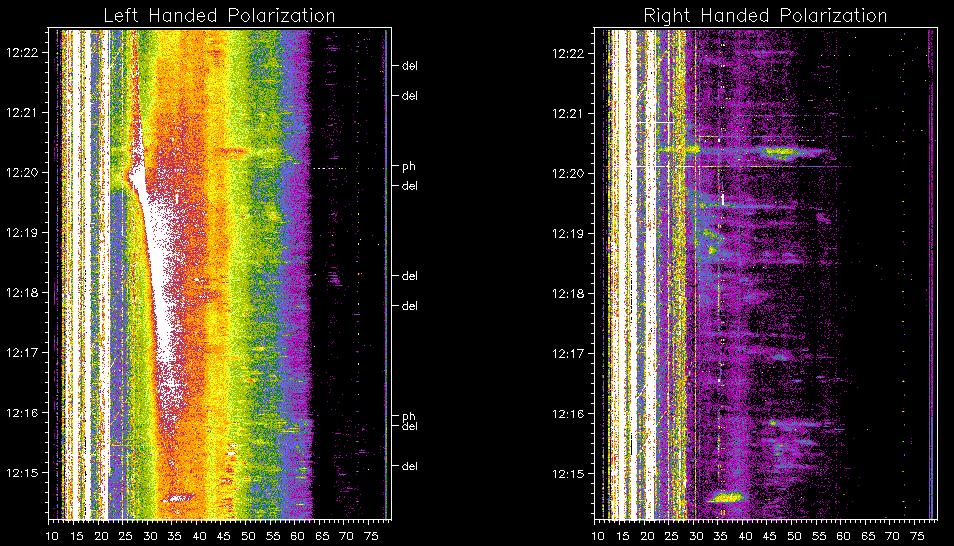Many thanks to the Taxpayers of France, the Nancay Decametric Array Team at the Nancay Radio Astronomy Station of Paris Observatory, Trinity College Dublin Astrophysics Group, NOAA SWPC, and NASA SDO HMI Magnetograph Team.
Friday, January 31, 2014
Tuesday, January 28, 2014
Sun 140128, very nice events at Paris Observatory Nancay Station, 6 M class flares, 10 selected radio events
Many thanks to the Taxpayers of France, the Nancay Decametric Array Team at the Nancay Radio Astronomy Station of Paris Observatory, Trinity College Dublin Astrophysics Group, NOAA SWPC, Lockheed Martin Solar Laboratory, and NASA SDO HMI Magnetograph Team.
Sunday, January 26, 2014
van Haarlem and 191 collaborators 2013, "LOFAR: The LOw-Frequency ARray"
I refer to van Haarlem and 191 collaborators 2013, "LOFAR: The LOw-Frequency ARray":
http://adsabs.harvard.edu/abs/2013JInst...8P5012A
Abstract: "LOFAR, the LOw-Frequency ARray, is a new-generation radio interferometer constructed in the north of the Netherlands and across europe. Utilizing a novel phased-array design, LOFAR covers the largely unexplored low-frequency range from 10-240 MHz and provides a number of unique observing capabilities. Spreading out from a core located near the village of Exloo in the northeast of the Netherlands, a total of 40 LOFAR stations are nearing completion. A further five stations have been deployed throughout Germany, and one station has been built in each of France, Sweden, and the UK. Digital beam-forming techniques make the LOFAR system agile and allow for rapid repointing of the telescope as well as the potential for multiple simultaneous observations. With its dense core array and long interferometric baselines, LOFAR achieves unparalleled sensitivity and angular resolution in the low-frequency radio regime. The LOFAR facilities are jointly operated by the International LOFAR Telescope (ILT) foundation, as an observatory open to the global astronomical community. LOFAR is one of the first radio observatories to feature automated processing pipelines to deliver fully calibrated science products to its user community. LOFAR's new capabilities, techniques and modus operandi make it an important pathfinder for the Square Kilometre Array (SKA). We give an overview of the LOFAR instrument, its major hardware and software components, and the core science objectives that have driven its design. In addition, we present a selection of new results from the commissioning phase of this new radio observatory."
http://adsabs.harvard.edu/abs/2013JInst...8P5012A
Abstract: "LOFAR, the LOw-Frequency ARray, is a new-generation radio interferometer constructed in the north of the Netherlands and across europe. Utilizing a novel phased-array design, LOFAR covers the largely unexplored low-frequency range from 10-240 MHz and provides a number of unique observing capabilities. Spreading out from a core located near the village of Exloo in the northeast of the Netherlands, a total of 40 LOFAR stations are nearing completion. A further five stations have been deployed throughout Germany, and one station has been built in each of France, Sweden, and the UK. Digital beam-forming techniques make the LOFAR system agile and allow for rapid repointing of the telescope as well as the potential for multiple simultaneous observations. With its dense core array and long interferometric baselines, LOFAR achieves unparalleled sensitivity and angular resolution in the low-frequency radio regime. The LOFAR facilities are jointly operated by the International LOFAR Telescope (ILT) foundation, as an observatory open to the global astronomical community. LOFAR is one of the first radio observatories to feature automated processing pipelines to deliver fully calibrated science products to its user community. LOFAR's new capabilities, techniques and modus operandi make it an important pathfinder for the Square Kilometre Array (SKA). We give an overview of the LOFAR instrument, its major hardware and software components, and the core science objectives that have driven its design. In addition, we present a selection of new results from the commissioning phase of this new radio observatory."
Sun 140126, 10 selected events
Many thanks to the Taxpayers of France, the Nancay Decametric Array Team at the Nancay Radio Astronomy Station of Paris Observatory, Trinity College Dublin Astrophysics Group, NOAA SWPC, and NASA SDO HMI Magnetograph Team.

























































